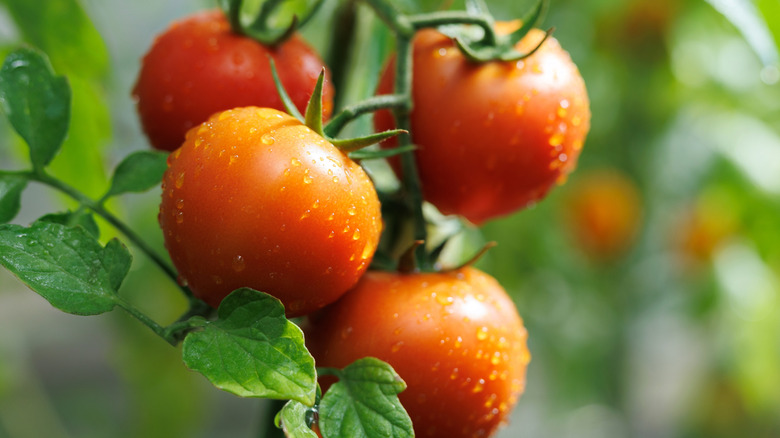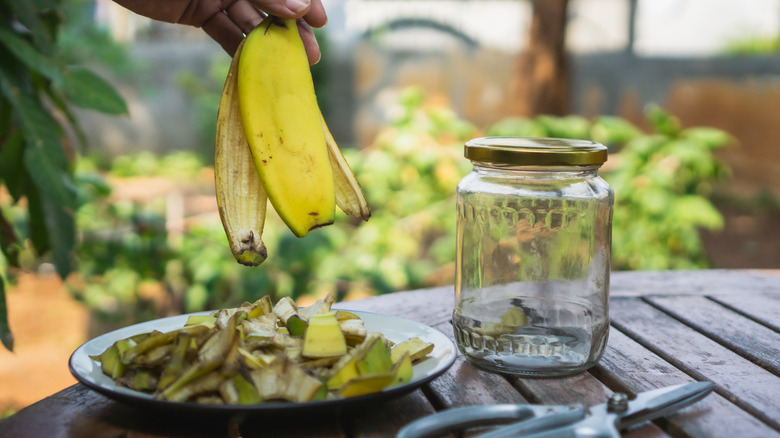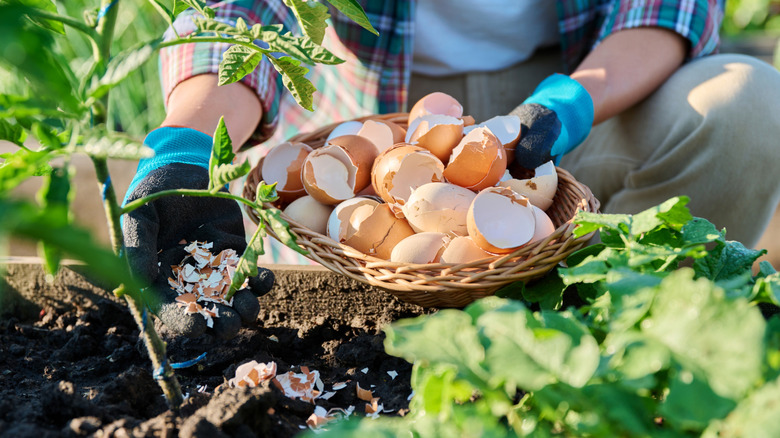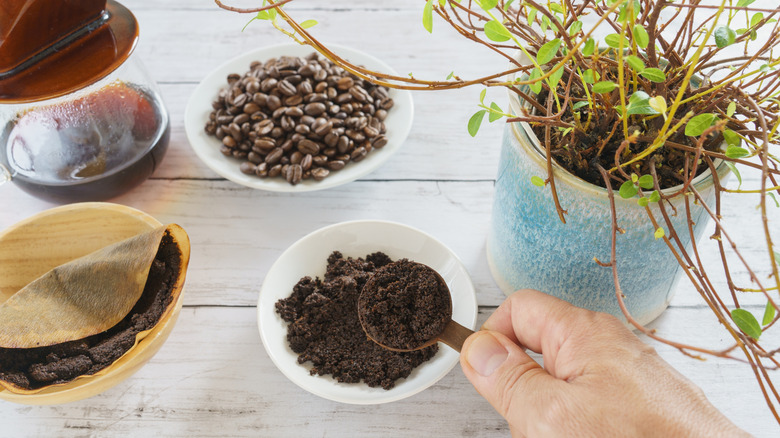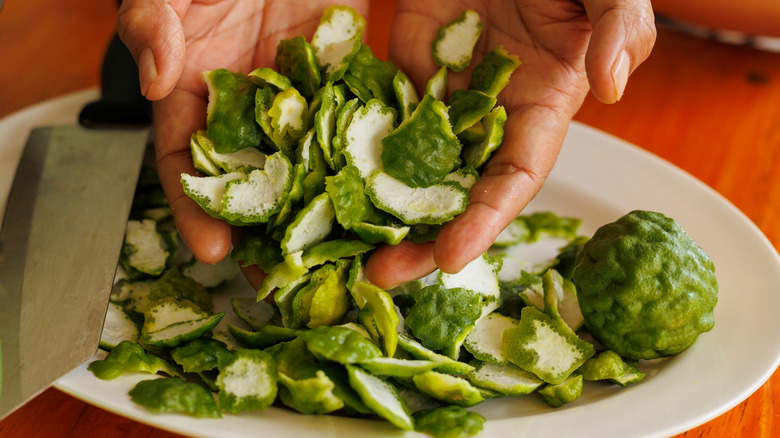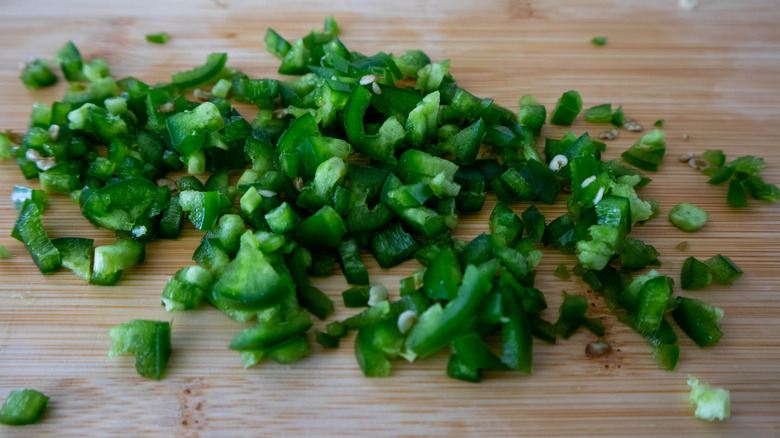5 Kitchen Scraps That Help Your Garden Tomatoes Flourish
Whether or not you're new to farming tomatoes in your home garden, you might be looking for ways to facilitate their growth. For instance, it always pays to plant basil near your tomato plants, because of its flavor-enhancing and pest-deterring qualities (among others). And, since it's possible to use kitchen scraps to regrow foods – such as green onions and peppers — it only makes sense that you can also use leftover foods to nourish the soil.
Food scraps are one of the core ingredients in compost; Alone, they decompose slowly and release nutrients into the soil and plants. Banana peels, coffee and tea grounds, eggshells, and citrus and spicy foods are some of the best scraps you can use for homegrown tomatoes. Plus, some of these can keep pests at bay so your tomato plants can thrive. So, let's deep dive into each to find out why they're so beneficial for cultivating these fruits and how to use them.
Banana peels
Did you know that cuisines around the world utilize banana peels in recipes? Making banana peel bacon (a vegan substitute) is one of many ways to make the most out of banana peels. Tomato plants love them, too. While these kitchen scraps contain various nutrients such as calcium, magnesium, and phosphorus, potassium is the main macronutrient and one of the most important for plants to produce flowers and fruits.
There are a few sustainable ways to get the potassium from banana peels into the soil and your tomato plants. To add them to compost, bury them in the soil, or soak them in water, cutting the rinds into ½ to 1-inch pieces, which is more beneficial than leaving them whole. Smaller pieces will break down faster and release their nutrients faster. You could even throw the peels into a blender.
Burying the banana peels is an effective way to improve the soil nutrients, while adding them to compost during winter is a great way to preserve the compost for the spring ahead. When soaking the rinds, pack the pieces into a glass jar, cover them with water, and set the jar in moderate sunlight for 24 hours. Then, you can use the nutrient-rich solution to water your tomatoes and enhance the fruiting process.
Eggshells
When cooking and baking, you probably crack open eggs and toss the shells into the garbage without a second thought (no judgment here). That's what most people do since only the yolk and egg white are considered useful. However, eggshells are a rich source of calcium because they primarily consist of calcium carbonate. While it's safe to eat eggshells with proper preparation, it's not the most appetizing prospect, but your tomato plants will thank you by flourishing from the extra nutrients. Most notably, calcium can hinder blossom end rot, a physiological problem in which the part of the fruit opposite the stem deteriorates and decays.
All you have to do to repurpose eggshells in your garden is break them into pieces and throw a couple of handfuls on the ground where you plan to grow your tomatoes. If you want to avoid getting leftover egg white on your hands, toss these kitchen scraps in a bowl and use a potato masher to break them up. Also, wear gloves to protect your hands from the edges when you spread them on the ground. The pieces will be effective, but the smaller you crush the eggshells, the quicker they will decompose and release nutrients into the soil for your tomatoes to absorb. That's why many gardeners use a blender or a mortar and pestle to turn the eggshells into a powder that's easy to sprinkle around the plant bases.
Coffee and tea grounds
It's easy to toss out coffee and tea after making a cup (or more), especially if you have foregone traditional coffee filters and use pods instead. However, one of the most surprising uses for coffee grounds is as a powerful fertilizer in your garden. Tomatoes particularly take a shine to coffee grounds and tea leaves, mainly because these kitchen scraps contain magnesium, nitrogen, and potassium, all of which help the plants grow. Just keep in mind that it can take months for microorganisms to break down the grounds for the nutrients to be released. Because of that, you may want to mix coffee and tea grounds into a compost or the soil well before you start planting.
Another garden benefit is that used coffee and tea grounds contain tannic acid (tannins) that slightly increase the acidity of the soil. Research suggests that the acidic effect is short-lived, so using additional fertilizers is recommended to ensure the ideal pH is between 6.0 and 6.8 for tomatoes to be productive. Mixing fresh grounds into the soil increases the acidity more but could damage the plants if you're too heavy-handed with it, so regular soil pH testing is advised if you do this.
Additionally, coffee and tea grounds naturally repel garden pests such as aphids, slugs, and snails when used as mulch because the coarse grounds irritate their bellies. You don't want to add too much to avoid attracting other pests. And, since the grounds are good at retaining moisture and compact easily, using an excessive amount can restrict airflow and oversaturate the soil, potentially leading to fungal problems with your tomato plants. Combining the grounds with lawn clippings, tree needles, or wood chips can prevent those issues.
Citrus rinds
There are many ways to put the rinds of citrus fruits to good use. Aside from zesting, using frozen citrus rinds in cold drinks (especially cocktails) adds depth of flavor and visual appeal. Your tomato plants will also be happy that you don't throw out your citrus rinds because they contain nitrogen, phosphorus, and potassium. For your tomatoes to get the most out of these nutrients, dry them out before chopping or grinding them up. Then, spread the rinds on the soil around the stems before watering or mix them into your compost.
Using the chopped or ground-up citrus rinds in your garden can also cover up fertilizer odors and repel ants because they dislike the smell. Peels from grapefruits, lemons, and oranges contain particularly high amounts of the oil d-limonene, a natural insect repellent. Just sprinkle the pieces or powder around your garden. Additionally, you can make an aphid deterrent in a spray bottle. All it takes is rinsing the rinds in hot water with a few drops of dish soap. Then, spray the stems and leaves closest to the soil. Because of the added soap, the solution will stick to your tomato plants so that the smell lingers.
Spicy peppers
If you enjoy spicy foods, you might use all types of peppers when you cook and throw out the scraps without knowing that you can use them in your garden to deter pests. Because of their active compound, capsaicin, which creates the burning sensation you experience when you eat them, spicy peppers (from chilis to jalapenos to ghost peppers) can deter unwanted guests in you garden. In mites and insects, the compound affects the nervous system and can damage cell membranes. Meanwhile, most wildlife have evolved to avoid it because of its strong scent and taste.
According to a study published in Restoration Ecology, capsaicin is a deterrent against rodents that dig up and eat plant seeds. Scientists used seed-coating techniques using ghost pepper powder in the field for four years and found that deer mice ate 86% fewer seeds.
Dusting the seeds with powder made from spicy peppers isn't the only way to use them to protect your tomatoes from garden pests — insects and mammals alike. Another option is to simply place the kitchen scraps around your plants, allowing them to naturally emit the capsaicin and spicy odor. You can make a hot pepper spray by mixing chopped pepper scraps (spicier is better because they have more capsaicin), water, and a little dish soap in a bottle. Apply the spray to bug-infested plants to kill the insects and prevent more from attacking. (On a side note, cinnamon is also a common pantry spice that benefits your garden because it contains capsaicin in minimal amounts and creates mouth and nose irritation that, when inhaled, keeps large pests like mice and squirrels away.)
